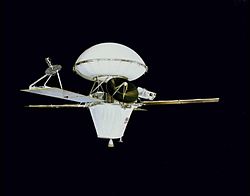Viking 1

Viking orbiter
|
|
| Mission type | orbiter and lander |
|---|---|
| Operator | NASA |
| COSPAR ID | Orbiter:1975-075A Lander:1975-075C |
| SATCAT № | Orbiter:8108 Lander:9024 |
| Website | Viking Project Information |
| Mission duration | orbiter:1846 days (1797 sols) lander:2306 days (2245 sol) |
| Spacecraft properties | |
| Manufacturer | Orbiter:NASA JPL Lander:Martin Marietta |
| Launch mass | Orbiter:883 kg (1,947 lb) Lander:572 kg (1,261 lb) |
| Power | Orbiter:620 W Lander:70 W |
| Start of mission | |
| Launch date | 21:22, August 20, 1975 |
| Rocket | Titan IIIE/Centaur |
| End of mission | |
| Last contact | November 13, 1982 |
| Orbital parameters | |
| Reference system | Areocentric |
| Mars orbiter | |
| Spacecraft component | Viking 1 Orbiter |
| Orbital insertion | June 19, 1976 |
| Orbit parameters | |
| Periareion | 320 km (200 mi) |
| Apoareion | 56,000 km (35,000 mi) |
| Inclination | 39.3° |
| Mars lander | |
| Spacecraft component | Viking 1 Lander |
| Landing date | July 20, 1976 11:53:06 (MSD 36455 00:34 AMT) |
| Landing site | 22°29′N 49°58′W / 22.48°N 49.97°W |
Viking 1 was the first of two spacecraft (along with Viking 2) sent to Mars as part of NASA's Viking program. On July 20, 1976, it became the first spacecraft to land successfully on Mars and perform its mission. Viking 1 held the record for the longest Mars surface mission of 2307 days or 2245 sols until that record was broken by Opportunity on May 19, 2010.
Following launch using a Titan/Centaur launch vehicle on August 20, 1975, and a 10-month cruise to Mars, the orbiter began returning global images of Mars about 5 days before orbit insertion. The Viking 1 Orbiter was inserted into Mars orbit on June 19, 1976, and trimmed to a 1513 x 33,000 km, 24.66 h site certification orbit on June 21. Landing on Mars was planned for July 4, 1976, the United States Bicentennial, but imaging of the primary landing site showed it was too rough for a safe landing. The landing was delayed until a safer site was found. The lander separated from the orbiter on July 20 08:51 UTC and landed at 11:53:06 UTC. It was the first attempt by the United States at landing on Mars.
The instruments of the orbiter consisted of two vidicon cameras for imaging (VIS), an infrared spectrometer for water vapor mapping (MAWD) and infrared radiometers for thermal mapping (IRTM). The orbiter primary mission ended at the beginning of solar conjunction on November 5, 1976. The extended mission commenced on December 14, 1976, after solar conjunction. Operations included close approaches to Phobos in February 1977. The periapsis was reduced to 300 km on March 11, 1977. Minor orbit adjustments were done occasionally over the course of the mission, primarily to change the walk rate — the rate at which the areocentric longitude changed with each orbit, and the periapsis was raised to 357 km on July 20, 1979. On August 7, 1980, Viking 1 Orbiter was running low on attitude control gas and its orbit was raised from 357 × 33943 km to 320 × 56000 km to prevent impact with Mars and possible contamination until the year 2019. Operations were terminated on August 17, 1980, after 1485 orbits. A 2009 analysis concluded that, while the possibility that Viking 1 had impacted mars could not be ruled out, it was most likely still in orbit.
...
Wikipedia
